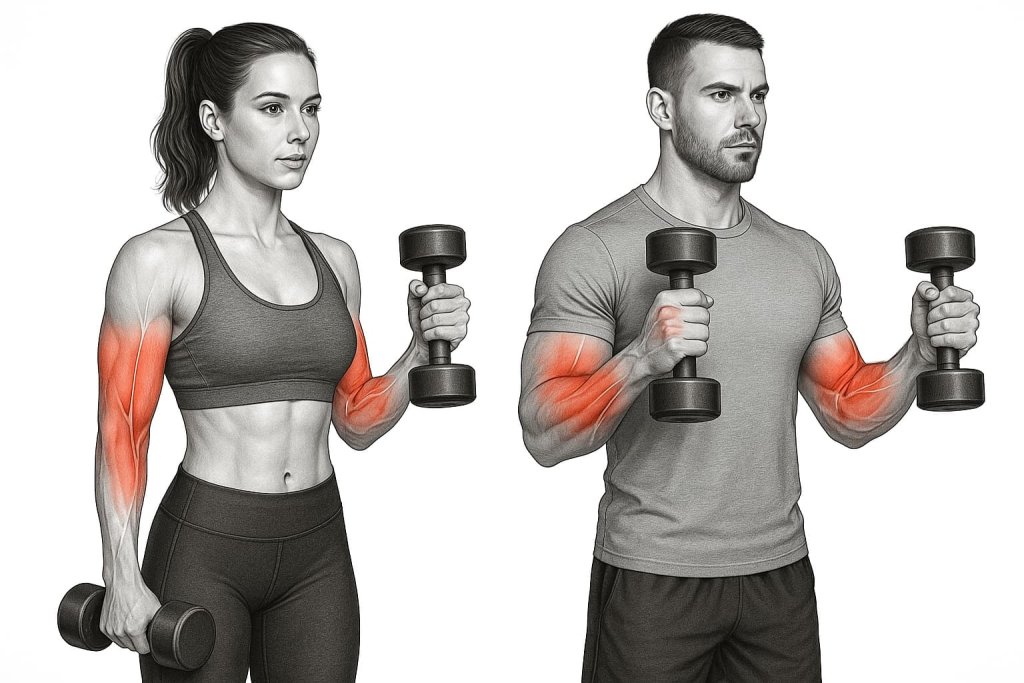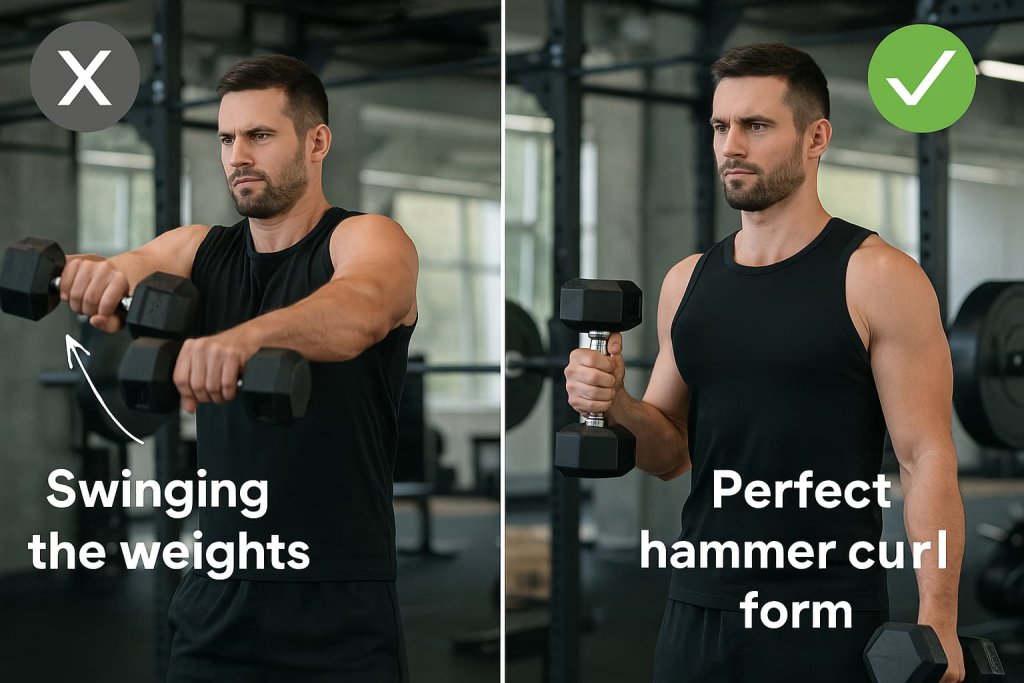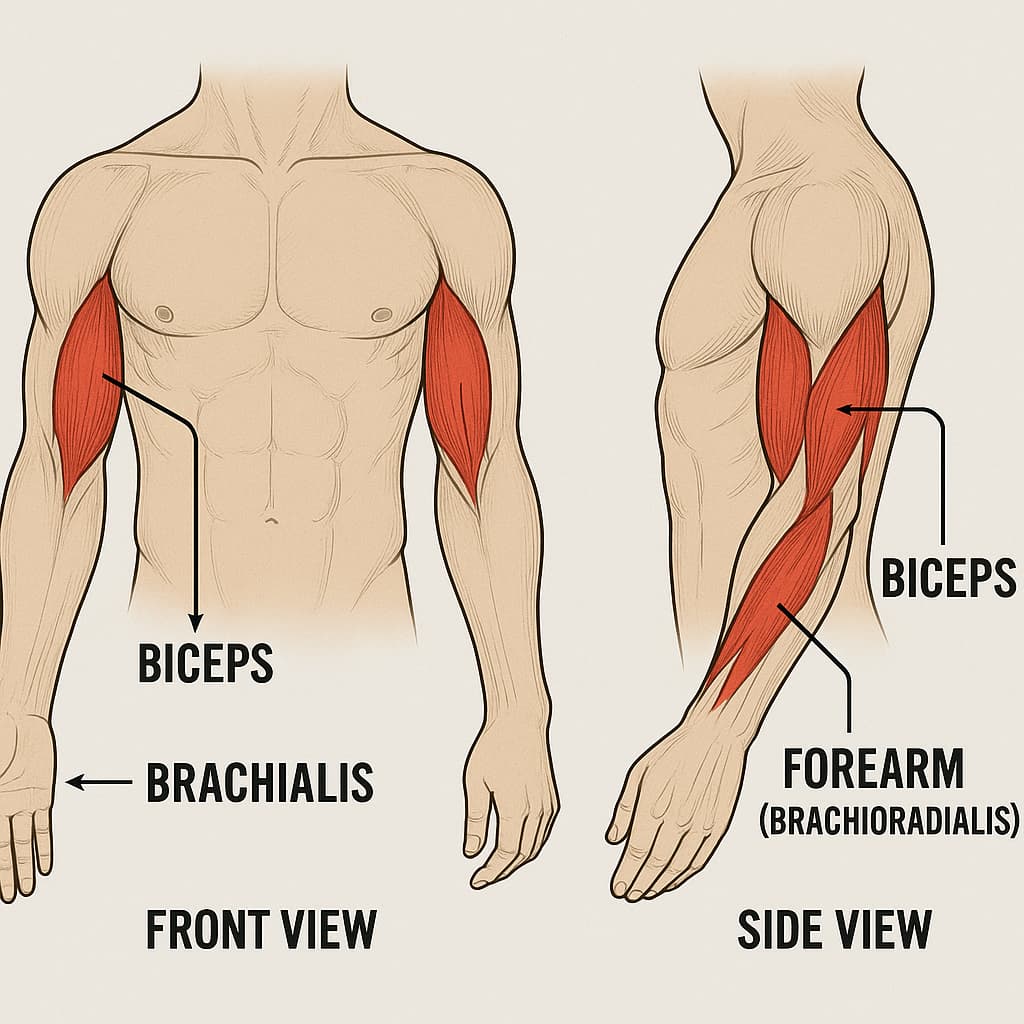Hammer curls are a powerful arm exercise that uniquely targets both the brachialis and brachioradialis muscles, resulting in bigger, stronger arms and enhanced grip strength. Unlike traditional biceps curls, the hammer curl uses a neutral grip, making it more joint-friendly and effective for overall arm development.

If you want to maximize your arm gains, prevent injuries, and add real width to your arms, mastering the hammer curl is essential. This guide covers hammer curl form, benefits, common mistakes, the best variations, alternatives, and expert tips—all using the latest research and coaching advice.
How to Do Hammer Curls: Step-by-Step Form

Proper form is the key to muscle growth, strength gains, and injury prevention. Follow these steps for the perfect hammer curl:
1. Setup
- Stand upright with feet about hip-width apart.
- Hold a dumbbell in each hand with your arms fully extended at your sides, palms facing each other (neutral grip).
- Pull your shoulders back, chest tall, and brace your abs.
2. Curling Up
- Without moving your upper arms, bend your elbows to curl the dumbbells upward toward your shoulders.
- Keep your elbows close to your body throughout the movement.
- Squeeze your biceps and forearms at the top, pausing briefly.
3. Lowering Down
- Slowly lower the dumbbells back to the starting position, maintaining control and tension.
- Fully extend your arms at the bottom, but do not lock your elbows.
4. Breathing & Tempo
- Exhale as you curl up, inhale as you lower down.
- Use a slow tempo (about 2 seconds up, 2–3 seconds down) for best results.
Form Tips:
- Do NOT swing your body or use momentum. If you can’t control the weight, use lighter dumbbells.
- Keep your wrists neutral—do not let them bend.
- Maintain a strong core and upright posture to avoid arching your back.
Muscles Worked in Hammer Curl

Hammer curls are unique because they emphasize not just the biceps, but other crucial arm muscles for thickness and real-world strength.
- Brachialis: Sits underneath the biceps brachii, provides most of the upper arm’s width when well-developed.
- Brachioradialis: Large forearm muscle, gives the forearm its size and strength, especially visible when the arm is flexed.
- Biceps brachii: Still highly activated, but with slightly less emphasis than in a supinated (palms-up) curl.
- Forearm flexors: Assist with grip, making this exercise great for overall arm function.
Science update:
A 2023 study in the Journal of Strength and Conditioning Research confirmed that hammer curls lead to significantly greater brachialis and brachioradialis activation compared to regular curls, helping boost overall arm size and grip strength (JSCR, 2023).
Benefits of Hammer Curl
- Increased arm thickness: Builds up the brachialis, which “pushes up” the biceps for a fuller look.
- Bigger, stronger forearms: Hitting the brachioradialis improves grip, helpful for sports, daily activities, and deadlifts.
- Healthier joints: The neutral grip puts less strain on your wrists and elbows, making hammer curls ideal for those with joint issues.
- Functional carryover: Strengthens the muscles used in real-world tasks like carrying groceries, pulling, or lifting objects.
- More balanced arm development: Complements biceps curls by targeting neglected muscles, preventing imbalances and injury.
Stat:
Research published in 2024 found that including hammer curls in your arm routine resulted in a 20–25% increase in brachialis size after 10 weeks, compared to curls alone.
Common Hammer Curl Mistakes & How to Fix Them
| Mistake | Why It’s Bad | How to Fix It |
|---|---|---|
| Using momentum/swinging | Less muscle tension, higher injury risk | Lower the weight, slow down |
| Elbows moving forward | Shoulders take over, arms less activated | Pin elbows to your ribs, stay strict |
| Bending wrists | Wrist strain, less forearm work | Keep wrists straight, neutral grip |
| Not fully extending arms | Incomplete muscle activation | Lower weights all the way each rep |
| Rushing reps | Poor muscle recruitment, less growth | Slow, controlled reps (2s up, 2s down) |
Tip: Film yourself or use a mirror to keep your technique strict.
Hammer Curl Variations for All Levels
1. Alternating Hammer Curl
How to Do It:
- Stand with a dumbbell in each hand, arms at your sides, palms facing your body (neutral grip).
- Curl one dumbbell toward your shoulder while keeping the other arm stationary.
- Pause at the top, then slowly lower back down.
- Alternate arms for each rep.
Muscles Worked:
- Brachialis (primary)
- Biceps brachii (secondary)
- Brachioradialis (forearm)
Benefits:
- Reduces strain on wrists and elbows by using a neutral grip.
- Allows focus on form and control with each arm individually.
- Helps correct muscular imbalances between arms.
Trainer Tip:
Keep your elbows close to your sides and avoid swinging your body to lift the weight.
2. Cross-Body Hammer Curl (Diagonal Curl)
How to Do It:
- Hold dumbbells at your sides with palms facing in.
- Curl one dumbbell across your torso toward the opposite shoulder, keeping your palm neutral.
- Lower back down and repeat on the other side.
Muscles Worked:
- Brachialis
- Brachioradialis
- Forearm muscles
Benefits:
- Places even more emphasis on the brachialis and forearms, giving the arms a thicker appearance.
- Provides a different angle of resistance for more complete arm development.
Trainer Tip:
Don’t rotate your wrist at the top—keep the neutral grip throughout. Move only at the elbow, not the shoulder.
3. Seated Hammer Curl
How to Do It:
- Sit upright on a bench with back support, feet flat on the floor.
- Hold dumbbells at your sides with palms facing in.
- Curl both arms simultaneously toward your shoulders.
- Lower slowly to the start position.
Muscles Worked:
- Brachialis
- Biceps
- Forearms
Benefits:
- Reduces momentum and body swing, forcing strict form.
- Isolates the arms by taking your lower body out of the movement.
Trainer Tip:
Keep your back flat against the pad and focus on a slow, controlled lift and lower.
4. Incline Hammer Curl
How to Do It:
- Set a bench at a 45-degree incline.
- Sit back, let your arms hang straight down holding dumbbells, palms facing in.
- Curl both arms upward without moving your shoulders.
- Lower with control.
Muscles Worked:
- Brachialis
- Biceps (especially long head)
- Forearms
Benefits:
- Greater stretch at the bottom increases muscle activation, especially for the long head of the biceps and brachialis.
- Enhances the mind-muscle connection by limiting body movement.
Trainer Tip:
Keep your shoulders pinned to the bench; don’t let them roll forward as you curl.
5. Rope Hammer Curl (Cable)
How to Do It:
- Attach a rope handle to a low pulley on a cable machine.
- Stand tall, grab the rope with both hands, palms facing in.
- Curl the rope toward your shoulders, keeping elbows at your sides.
- Spread the rope ends apart slightly at the top.
- Lower slowly to the start.
Muscles Worked:
- Brachialis
- Brachioradialis
- Biceps
- Forearms
Benefits:
- Provides constant muscle tension through the full range of motion.
- Easy to adjust resistance for progressive overload.
- Spreading the rope at the top gives a peak contraction.
Trainer Tip:
Move slowly and avoid letting the weights “slam” at the bottom for maximum muscle engagement.
Comparison Table: Hammer Curl Variations
| Variation | Best For | Unique Benefits | Equipment Needed |
|---|---|---|---|
| Alternating Hammer Curl | All levels | Focus on each arm, strict form | Dumbbells |
| Cross-Body Hammer Curl | Intermediate+ | Extra brachialis & forearm activation | Dumbbells |
| Seated Hammer Curl | Beginners/Isolation | Eliminates cheating, strict form | Dumbbells, Bench |
| Incline Hammer Curl | Muscle growth | Deep stretch, long head and brachialis focus | Dumbbells, Incline Bench |
| Rope Hammer Curl (Cable) | Constant tension, gyms | Adjustable resistance, peak contraction | Cable Machine + Rope |
Hammer Curl Alternatives
- Reverse Curl: Use a palms-down grip to focus even more on the brachioradialis and forearms.
- EZ-Bar Curl: More wrist-friendly than straight bars; can use a semi-pronated grip.
- Preacher Hammer Curl: Performed on a preacher bench to maximize strictness and brachialis isolation.
- Standard Biceps Curl: The classic curl, best for peak biceps development.
- Zottman Curl: Combines an up (supinated) curl with a down (pronated) eccentric, for all-around arm growth.
Trainer Tips for Bigger Arms
- Focus on the squeeze: Pause at the top of each rep and really feel the muscles working.
- Progressive overload: Increase weight or reps weekly to keep growing.
- Keep it strict: Use less weight if your form slips—quality beats quantity.
- Balance your routine: Pair hammer curls with traditional biceps and triceps moves for symmetry.
- Best programming:
- Beginners: 2–3 sets of 10–15 reps, twice per week
- Intermediates/advanced: 3–4 sets of 8–12 reps, or heavier 6–8 rep sets
- Rest & recover: Don’t overtrain—leave 48–72 hours between arm workouts for best gains.
Frequently Asked Questions (FAQ)
Q: Are hammer curls better than regular biceps curls?
A: No, they’re complementary. Hammer curls target the brachialis and forearms more, while traditional curls focus on the biceps brachii. For best results, include both.
Q: How often should I do hammer curls?
A: Once or twice per week, as part of your arm or upper-body workouts.
Q: Are hammer curls good for elbow pain?
A: Yes! The neutral grip is usually easier on sore elbows and wrists.
Q: When can I expect results?
A: Visible changes in arm thickness and strength can show up in as little as 4–8 weeks with consistent training and progressive overload.
Q: What weight should I use?
A: Choose a weight that challenges you, but allows perfect form for all reps.
Conclusion
Hammer curls are a game-changing arm exercise for anyone serious about building arm size, forearm strength, and joint health. The neutral grip hammers the brachialis and brachioradialis for extra width and functional power—something regular curls can’t match.
If you want arms that are as strong as they look, add hammer curls to your routine starting this week. Focus on perfect form, avoid common mistakes, and gradually challenge yourself for long-term results.
